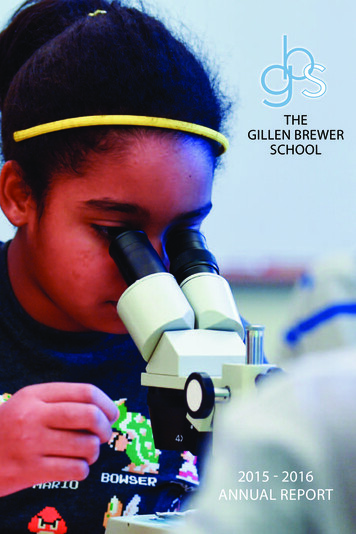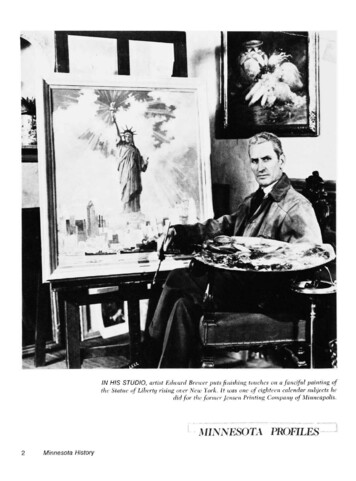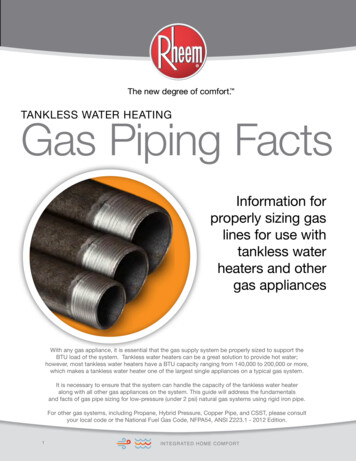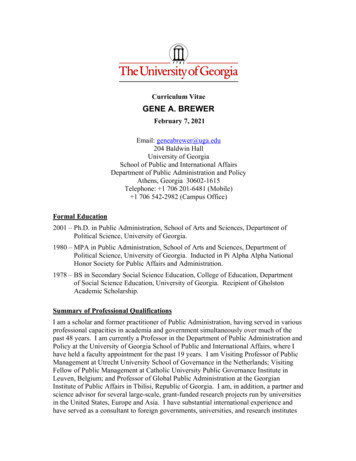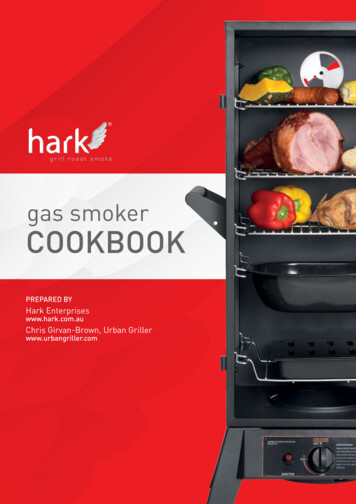
Transcription
grill roast smokegas smokerCOOKBOOKPREPARED BYHark Enterpriseswww.hark.com.auChris Girvan-Brown, Urban Grillerwww.urbangriller.com
grill roast smokeHark would like to thankChris Girvan-Brown ofUrban Griller for hisINDEX1. About the Hark Gas SmokerFeatures & Benefits2. Getting Started112invaluable contribution to2.1 Seasoning the smoker2this cookbook. We greatly2.2Working with the right equipment22.3Firing up your smoker3appreciate his extensiveexpertise in the field ofsmoking & barbequingand are grateful forhis wonderful range ofmouth-watering recipes.Tips and Warnings33. Flavouring Techniques43.1Wood chips3.2 Other smoking materials4. Preparation Treatments4.1456Brine curing6Basic brine recipe64.2 Salt and sugar curing74.3 Marinades7Simple marinade4.4 Dry rubsBasic rub5. Smoking Methods5.1Hot smokingLow & slow5.2Cold smoking6. Temperature Control6.1 Internal temperaturesHints & Tips6.2 Typical temperatureswith rear vent fully open6.3 Developing reliable techniques7. Tips on using your ood safety & care118. Looking after your Hark Gas Smoker12i
grill roast smokeGAS SMOKER RECIPESSmoked salmonKippering oily fishSmoked troutSmoked oystersHot smoked musselsHot smoked salmon variationSmoked chickenChicken breast wrapped in ProsciuttoOlive brined quailSmoked beef brisket with barbecue sauceSpiced garlic beef stripsClassic dry cured smokey loin (Canadian) baconKansas City smoked pork ribs (American style ribs)“Same day” Texas spareribsBasic German sausageBasic English breakfast sausagesBreadHand made breadSmoked pumpkin pieSmoked Portobello mushroomsSmoked roast potatoSmoked tomatoSmoked lemonsSmoked pearsSmoked applesSmoked garlicSmoked saltHomemade smoked almondsSmoked chocolate potsClassic barbecue sauceCamembert pies12 hour steakSmoker Cooking 435353637373839404143-44ii
1. ABOUT THE HARKgrill roast smokeGAS SMOKERCongratulations on your purchase of theHark Gas Smoker oven. The Smoker allowsyou and your family to enjoy a wide rangeof professionally smoked produce preparedin your own back yard. With minimal effortrequired, you can impress your guests withrestaurant quality smoked trout, pork ribs orbeef jerky. The options are endless.FEATURES &BENEFITSGas powered so you can achieve consistenttemperatures for even cooking.Back-exhaust vent for smoke and temperatureregulation.Push start Piezo ignition.Sturdy construction with a wide and stable legpattern providing extra stability.Four fully adjustable chrome plated shelvesenabling large quantities of meat or fish to besmoked in the one batch.Hose and regulator included. POL connection fitsmost standard BBQ gas bottles.Enamel coated water pan helps keep food fromdrying out over long smoking periods. Alsoenables spices or marinades to be added to thewater to provide extra flavour.Large enamel coated wood chip box.Cast brass burner.Large temperature gauge for easy reference.Heat resistant side handles for easy movement.1
grill roast smoke2. GETTING STARTEDplease ensure that you have carefully read andunderstood the WARNINGS AND INSTRUCTIONS andthe detailed assembly instructions contained INHark Gas Smoker Manual. this manual can be foundinside the hark gas smoker gift box or on ourwebsite www.hark.com.au.2.1 Seasoning the SmokerThis process is simple and will coat the inside of your Gas Smoker Oven with a thinfilm of smoke residue that will help protect it.Refer the following steps:- After carefully following the assembly instructions contained in the Hark UserManual, carefully wash the inside and outside of the Hark Gas Smoker with warmwater and a little dishwashing detergent in it. Rinse clear with clear water andleave to dry thoroughly.- Lightly spray the shelves and inside walls with canola oil.- Fill the Wood chip box with woodchips, then light the smoker and set the gascontrol to MEDIUM.- DO NOT USE THE WATER BOWL.- Once your Gas Smoker Oven fills up with smoke, leave the smoker to “season” forapproximately 30 minutes.- Your Hark Gas Smoker is now seasoned and ready to use!- It is good practice to re-season your smoker at regular intervals, and once a yearat the very least.2.2 working withthe right equipmentBefore commencing cooking with the Hark Gas Smoker, it pays to ensure you haveall the necessary tools and utensils required to achieve the best cooking results.- Prior to using the Hark Gas Smoker we recommend that you invest in two typesof thermometers. The first thermometer can be used for checking the insidetemperature of your smoker box. There are several digital oven thermometersthat are available in the marketplace, some of which are remote. The secondthermometer is used to check the internal temperature of the meat being smoked.Here you can use products such as the Hark Digital Thermometer or a HarkStainless Steel Meat Thermometer to periodically check the internal temperatureof the meat. A word of warning - never wash a temperature probe. Always wipeclean with a damp cloth and never immerse it in water.- It is important to understand that whilst the smoker’s outside temperature gaugewill give you an indication of the temperature inside your smoker, a specific internalthermometer (digital preferably) will help to achieve more accurate results.2
grill roast smoke- A pair of handy BBQ tongs for smaller pieces of meat or a meat hook for largercuts are recommended to safely handle the meat during the cooking process (forbasting etc) and to safely take it out when you have finished.- We also suggest you have a good pair of extra long, heavy duty barbecue mitts sothat you do not burn your hands or forearms. These are particularly necessary forwhen adding water or wood chips to the smoker during the smoking process.- Aluminium foil is also recommended to wrap around the meat once it has reachedthe desired temperature and colour. The foil will help prevent the wood resinsfrom further darkening the meat.- It is also a good idea to line the wood chip box and water pan with foil before use.This can make the cleaning process a lot easier later.2.3 FIRING up YOUR smoker- Soak your smoker wood chips in a separate bowl of water for at least 20 minutesprior to smoking. This will give a longer burn time and improve the smoky flavour.- Place the smoker outside in a well ventilated area.- Line the wood chip and water pans with aluminium foil to minimise cleaning later.- Fill the woodchip pan with woodchips and insert the pan into the bottom of thesmoker.- Insert the water tray and add hot water. Other liquids can be used, such as beer orwine.- Insert clean cooking grills at the levels you want and lay the meat on the grill.Always place the smaller pieces on the lower grid if double loading.- Remember that some meats will drip during the cooking process, so placevegetables on a shelf above the meat to eliminate contamination.tips and warnings- Install a BBQ mat under the smoker unit to avoid staining your flooring.DO NOT use the smoker if it is raining or snowing outside.- Air flow is important in this type of smoker. Set the rear vent to about ½ open thisshould allow plenty of air into the smoker and provide a good supply of smoke flowpast the meat.- You may find that for future cooking sessions, the vents will need to be adjusted.This is part of getting to know your smoker and an essential part to the art of smokecooking. It’s a good idea to take notes whenever you cook and make adjustmentsas necessary.- CAUTION: The wood chip box and lid become very hot during the smoking process.Always wear protective BBQ mitts or use long handled tongs when adding woodduring the smoking process.3
grill roast smoke3. FLAVOURING TECHNIQUESWood chips, sawdust or wood pellets are considered to be premium smokegenerating materials and greatly impact on the quality of the foods you choose tosmoke.3.1 wOod chipsIt is important to use the right smoking wood for a particular type of meat. Thisensures quality smoked product. Listed below are popular smoking wood types.These and specialised wood blends can be purchased from your local BBQ store.HickoryHickory has a strong, full flavour which can be used to smoke most meats, especiallypork ribs, sausages, brisket, steak, lamb, whole chicken and fish.Red GumRed Gum produces a strong bitey flavour and is highly recommended for smokingpork ribs, chicken wings and lamb.MesquiteMesquite is fast burning with a heavy smoke flavour which should be used in smallerquantities. It can be used to smoke all types of meat.Alder and CedarAlder and Cedar have a light, aromatic flavour almost sweet and are best used forsmoking fish such as trout and salmon.Apple and Cherry BlendApple and Cherry blend has a sweet, fruity flavour. It is mainly used to smokechicken, pork and vegetables.NEVER USE ANY PINE WOODS, TREATED, PAINTED OR STAINED WOODS IN YOURSMOKER. THESE WOODS CAN GIVE OFF TOXIC FUMES TO THE FOOD YOU ARECOOKING!As a general rule, the wood of any plant which bears an edible fruit is usable - grapevine cuttings and olive tree wood for example - and small wood chips work bestinside the Hark Gas Smoker wood chip box.Experiment with different types and quantities of wood chips and note that you canmix different types of wood chips together.4
grill roast smoke3.2 other smoking materialsOther materials than can be used in the smoking process, including herbs, spices,rice, tea, seaweed, nut shells. The resulting flavours can be subtle or in other casesstrong and pungent. This is where it can be beneficial to experiment with addingnew ingredients to the smoking process and is a good idea to keep notes for futurereference.Smoking pellets can also be used and are becoming more available in theAustralian market.5
grill roast smoke4. PREPARATION TREATMENTSThere are a number of methods that can be used to tenderise, moisten and flavouryour food. These range from brining to curing and marinating.4.1 BrinE CURINGBrining foods in a salt water mixture is a form of curing and is one of the simplesttechniques to prepare foods for smoking.The brining of meats is an age-old process for preserving foods. Heavy concentrationsof salt helped preserve meats for long ocean voyages and military campaigns beforethe arrival of refrigeration.Brining today uses smaller quantities of salt, mixed with other spices and herbs, andis used to flavour and tenderise meat. The most basic brining mixture incorporates aminimum of 1 tablespoon of salt to every 1 litre of water. We recommend salt flakesas they are easier to dissolve and the use of iodised salt where possible. A good ruleof thumb for achieving an effective brine cure is that it should contain enough salt inthe mixture to allow a raw egg to float. This equates to 20% of the salt in the liquid.And while it may seem like a lot, it is an essential part of the curing process and isnot simply for flavouring food.In terms of the quantity of brine required, you will need enough brine to completelysubmerge the meat without any part being out of the liquid and some foods mayneed to be weighed down to stay submerged.Meat is best brinned for approximately 4 hours per kilogram. Depending on the sizeof what you want to brine, it can take up to 24 hours or more. If you are going to bebrining whole poultry you will also want to add an additional 6 to 12 hour periodbetween brining and cooking. If you want your poultry to have a golden, crispy skin,it needs to sit in the refrigerator for several hours after you remove it from the brineso that the skin can dry before cooking.Also, when brining poultry or pork in a low salt brine, it is recommended that youchange the brining liquid every 24 hours. Beef and lamb however can be submergedin the same brine for up to 3 days.Once you have finished brining, lightly rinse the cut of meat to remove any excesssalt before cooking. Do not reuse the brine.Basic brine RECIPE- 1 litre of water.- 1 tablespoon of salt.This mixture can be flavoured with anything you like - crushed garlic, lemon,peppercorns, herbs, a teaspoon of good curry paste, brown sugar, soy sauce orginger, just to name a few.Soak the meat in the brine and place in the refrigerator overnight. Ensure that themeat is fully submerged in the brine.Note: There is an increasing push to include iodised salt in our cooking. This is avery good idea. However, we do not recommend using iodised salt in brineswhen you will be smoke cooking.6
grill roast smoke4.2 SALT AND SUGAR CURINGSalt and sugar curing is an age-old technique that involves removing all the availablemoisture from the food in order to prevent it from spoiling. Once foods are cured thisway, they are generally hung up in the open air or left packed in salt or sugar.When the food is required for consumption later, it is generally reconstituted witha liquid, such as water. Salt and sugar curing can be enhanced with the addition ofpepper, herbs or honey for extra flavour.4.3 MARINADESMarinades are liquids or pastes comprising a mixture of spice or herbs, used toflavour and tenderise meat over generous periods of time.Marinades are used to increase the flavour of foods but a common problem withthem is that often contain far too much sugar for close-contact cooking such asbarbeques or fry pans. Marinades are perfect for smoking however, because thetemperatures used in this cooking environment are not high enough to burn thesugars.simple marinade- 1 cup white wine- 1 cup grape seed oil- Juice from one lemon- 3 crushed cloves of garlic- 3 or 4 stems of rosemary- 1 teaspoon of crushed pepperPlace meat in a glass or ceramic bowl. Cover meat with the marinade and refrigerateovernight.4.4 DRY RUBSDry rubs are generally comprised of a mixture of dry herb and spices combined withsalt and sugar. These rubs help ‘dry’ the food by extracting moisture from the meat.Used properly, dry rubs can function like a combination of brining and salt or sugarcuring. Generally rubs are applied on the outside of the meat the day before andallowed to refrigerate over night.If smoking for long periods, it is advisable to apply the dry rub in small batchesthroughout the cooking process. Or as an alternative, add the dry rub towards theend of the smoking process in order to ensure the spice flavours are at their peak.Note: Wet rubs are essentially dry rubs combined with a wetting agent, such as oliveoil, beer, wine or fruit juice.Basic rub- 1 tablespoon cumin powder- 1 tablespoon smoked paprika- 1 teaspoon black pepper powderRub the meat with a clove of garlic, then rub with the rub mixture and leave in aplastic bag in the fridge overnight.7
grill roast smoke5. SMOKING METHODSDepending on the type of food being smoked, two basic smoking techniques apply.5.1 HOT SMOKINGHot smoking occurs when heat is used to cook foods in a smoke filled environment.Hot smoking takes place when cooking in an environment that has temperaturesgreater than what is considered to be normal ambient temperatures. Typically, hotsmoking is carried out in temperatures between 70 C and 180 C. It is importantto note that hot smoking alone does not act to preserve food. Anything hot smokedshould generally be stored in a refrigerator.low & slowMost meats are smoked at temperatures between 110-120 C. It should be notedthat classic smoked dishes like ribs and pulled pork will soften greatly and increasein flavour if you can hold them at temperature for a few hours inside the cookingchamber.Temperature control is essential to smoking successfully. Practice keeping yoursmoker at a stable temperature in the smoking “zone” for hours at a time, don’t betempted to open the door as this lets out heat and air in and that can set the stabletemperature back 15 minutes.Learning to create the smoke you want is also part of the art of smoking, sometimesless is more. The woodchip box does not have to be full all the time.5.2 cOLD SMOKINGCold smoking involves smoking partially cured foods with very little heat. This is apopular smoking method for foods such as nuts, fish, jerky and foods that are driedor cured prior to smoking. It is important to remember that cold smoking is not acooking process and that foods that are cold smoked aren’t actually ‘cooked’.Insteadthey are cured and preserved. This can allow foods to be edible for hours, days,weeks or months after smoking.It is always advisable to employ safe food practices when cold smoking and ensurethat you follow recipe instrutions very carefully.8
grill roast smoke6. TEMPERATURE CONTROL6.1 INTERNAL TEMPERATURESMost people will know their preference for how they like their meat cooked – rare,medium rare, medium or well done. This is largely a visual response and a blindfoldedsubject will most often prefer a rarer sample to what they would normally order.So how can we make sure chicken isn’t pink on the inside without over cooking it, orhow can we know that the rare roast beef (or steak) is actually rare on the inside?We could use an “Estimation” chart which are largely unreliable, or we could checkthe meat’s internal temperature.Here’s a basic chart of the Internal Temperatures for common eef,VealandSteak49 C - 52 C55 C - 57 C60 C - 63 C66 C - 68 C71 CLamb57 C60 C - 66 C71 C74 C71 C77 CPorkChickenBreast: 77 CThigh: 83 CIt is also important to note that an internal temperature may tell you from asafety point of view, that a meat is fit to eat. But, it is also important to take intoconsideration the type of meat being smoked. By way of an example, a beef brisketmay be safe to eat when the internal temperature reaches 55 C, however it is notnecessary when the meat is at its most tender. Due to the fact that this type of meatis full of connective tissue (collagen), it needs to be broken down over time beforethe meat becomes tender.In this instance, holding a certain internal temperature for specific durations isimportant to achieving a perfectly cooked piece of smoked meat.HINTS & TIPSLearn from experience: When smoking a piece of beef or lamb, check the internaltemperature before you start and thereafter every 10 minutes until it is cooked. Writeall this down on a chart. Do the same thing the following week, with an identicalpiece of meat, checking every 20 minutes (this will take a little less time as you arenot letting the heat out all the time). Write this down! Next week do the same thingbut check every half-hour. Keep going like this with other cuts of meat and soonyou will have a chart that can tell you how long the Hark Smoker takes to cook anygiven cut of meat. The next time someone asks “when will the roast be ready?”, youcan check the temperature and know that your smoker will take seven minutes and40 seconds to finish!9
grill roast smokeRest the meat: It is crucial that you allow meat to rest after the smoking processhas ended and before you commence carving. Always wrap the meat in foil and keepit warm with a towel. This process is vital in allowing meat to relax, re-incorporatethe juices and ensure it is as tender as it can possibly be. It is advisabe to rest a roastfrom 20 to 40 minutes and a piece of steak from 5 to 10 minutes.6.2 TYPICAL TEMPERATURESWITH REAR VENT FULLY OPENThe rear vent in the Hark Gas Smoker can be used to make small temperatureadjustments. The more the vent is open, the more heat and smoke escapes.If you want a more intense smoke flavour, keep the rear vent closed to ensure thesmoke does not escape. But if you do this, it is important to ensure that temperaturesdo not get too high.Note that the rear vent cannot be fully closed. This is a safety feature and it providesthe gas flame with minimum airflow required to operate efficiently.Below is a rough guide of smoking cooking temperatures with the rear ventfully open:- Low: 300 F (150 C)Slow smoking for delicate foods: fish, vegetables, nuts etc. Ideal for food warming.- Med: 350 F (180 C)Smoke cooking for meats, ribs, chicken etc. Good for baking.- High: 400 F (200 C)Smoke roasting, roast cooking, baking and general oven cooking.6.3 Developing reliable techniquesThe best way to develop reliable smoke cooking techniques is firstly understand theprocesses you are working with and to record your every step. This is a great way torefine and develop your own recipes.Use the Hark Smoker Cooking Log as the basis for your recipe development, thesesheets have been specially designed to take into account all of the variables you mayexperience.Visit our website www.hark.com.au to download or print your free Hark SmokerCooking Log.10
grill roast smoke7. TIPS ON USING YOUR SMOKER7.1 GENERAL- Smoke cooking is about having fun, experimenting with different brining andcuring recipes, experimenting with different smoke producing agents.- If you are smoke cooking dry or fat-free products like rabbit or venison make sureyou use some water in the water pan.- Keep the notepad or Hark Smoker Cooking Log handy, you would be surprisedhow often you can come up with a great combination and not be able to rememberwhat you’ve done. [ Refer to the Hark Smoker Cooking Log ]- Finally, it is important to remember that it takes time to master smokingtechniques. Don’t get put off by the odd failure. Instead use these experiences torefine your processes for the next smoking adventure. Allow yourself enough timeand enjoy the process.7.2 COOKING- Ensure there is enough fuel for the Hark Gas Smoker to complete the cookingprocess. This includes the pre-heating stage.- It pays to pre-heat the Hark Gas Smoker before use, remove the wire trays andinstall, loaded with food after the smoker has been warmed.- Always use the best quality ingredients possible.- Always use a temperature probe so that you know what temperature the foodbeing cooked is.- Always make sure you know what temperature the cooking chamber is. You wantto avoid over-cooked food.- Make sure there is enough ventilation inside your smoke cooker. Do not allow foodto touch the walls or other pieces of food.7.3 food safety & care- Maintain a high standard of cleanliness when handling food. Cleanliness goes along way in preventing bacterial infection.- Keep different types of food in separate cooking batches. For example separatecooked fish from chicken.- Never use salt that contain additives. They can taint the food and change thechemical process dramatically. There is a push nowadays to include iodine in oursalt intake. This is a great idea but it’s best not used in smoke cooking.- Always clean the ash pan and shelves of your Hark Gas Smoker after each use.11
grill roast smoke8. LOOKING AFTER YOURHARK GAS SMOKERMake sure you clean your Hark Smoker after each use. Remove the racks and wipeclean with a cloth or paper towel. Remove charcoal and ash.DO NOT USE CLEANING PRODUCTS ON THE INSIDE OF THE SMOKER. This willremove the seasoning and potentially ruin the flavour of your meal.Note: ‘Stove Bright’ satin black spray paint can be used for touch ups to the outsideof the Smoker only. Never spray this paint to the inside of the Smoker.12
grill roast smokegas smokerRECIPESPREPARED BYChris Girvan-Brown of Urban Grillerwww.urbangriller.com
grill roast smokeINGREDIENTSSMOKED SALMON6 salmon filet portionsBRINE:3 litres water½ cup salt (non-iodized)1 cup brown sugarDIRECTIONS- Dissolve the salt and brown sugar in water in plastic container- Submerge the salmon in the brine.- Cover with lid and store in the refrigerator overnight, 12-15 hours.- Remove the salmon from the brine. Rinse gently in cold water for10 minutes. Dry completely.- Place the salmon on lightly oiled racks to air dry in a cool place foranother hour or two to thoroughly dry.- Rub a thin coating of brown sugar onto each piece of salmon.- Sprinkle with cayenne pepper.- Preheat the Hark Gas Smoker, Smoke the salmon on 70 C (145 F)for 4-6 hours, adding an additional handful of chips halfwaythrough the cooking process, depending on your taste.- The temperature of the Hark Gas Smoker must reach 70 C (145 F)degrees or above and be sustained at this temperature for at leasthark gas smokerRECIPES30 minutes. This will kill any bacteria.14
grill roast smokeINGREDIENTSDIRECTIONSKippering Oily FishSardines, mullet or herring are ideal.- Wash the fish fillets to remove and blood and loose debris byplunging the fish into clean water.- The brining time for kippering depends mainly upon the size of thefish and the fat content.- Use an 80% brine solution (256g salt in 1 litre of water) andsubmerge the fish into the brine and refrigerate for 15 to 30minutes, depending on your taste.- Place the salmon on lightly oiled racks to air dry in a cool place foranother hour or two to thoroughly dry.- Smoke for 2 hours on the lowest possible heat, preferably no morethan 35 C (95 F).- Cool the kippers on a rack then store covered in the refrigerator.hark gas smokerRECIPESUse within 3 days, or, pack and freeze (for up to 3 months).15
grill roast smokeINGREDIENTSSMOKED TROUT6 or 8 whole trout (10-12 inches each), cleaned and rinsed4 cups water½ cup sugar½ cup non iodized salt2 tablespoons each chilli powder and garlic powder3 bamboo skewers, cut into 2-3 inch piecesDIRECTIONS- Mix all ingredients in a large bowl or pan until the sugar and saltare dissolved. Place the trout into the mixture, cover and marinateovernight in fridge.- The next day, drain the trout and pat dry.- Put the trout fillets between two layers of paper towels and letthem stand for 30 minutes.- Get the smoker oven ready.- Put 1 length of the bamboo skewer horizontally inside each trout tohold it open.- Smoke the trout on Low for about 3 to 4 hours. Replace the woodchips two or three times during the smokinghark gas smokerRECIPESprocess.- To add flavour to your smoked trout, glazeeach fillet with butter when the wood chips arebeing replaced.- This smoked trout recipe serves many and canbe stored in the freezer for up to 8 months.Use a vacuum sealer if you have one.16
grill roast smokeDIRECTIONSSMOKED OYSTERS- Boil a large pot of water. Remove the oysters from their shells andreserve the liquor. Put the oysters into the hot water. Stir them inthe water so they blanch evenly after 5 or 6 seconds.- Lay the oysters on a raised Hark Gas Smoker rack to dry.- Preheat the Hark Gas Smoker to 80 C (180 F).- Smoke using a light woodchip like Beech for 25 to 30 minutes.- Keep in a clean jar covered with oil. You can add crushed garlic andpepper to the reserved liquor and pour into the jar as well.hark gas smokerRECIPES- Store in the refrigerator for up to 2 weeks.17
grill roast smokeHot Smoked MusselsThese are an easy and tasty party finger food. They look great andcan be flavoured using common pesto and sauces in the baste.INGREDIENTS1 kg frozen “½ shell” New Zealand musselsFish sauceAluminium pizza trayPool saltDIRECTIONS- Remove the mussel from its shell and place it back, this makes iteasier for your guests.- Spread a couple of handfuls of pool salt on the pizza tray, set themussels into the salt so they don’t tip over.- Preheat the Hark Gas Smoker to 130 C (266 F).- Because the mussels are already opened they will have lost a lot oftheir juice so I always make a baste to use with them.- Add two tablespoons of fish sauce two cloves of crushed garlic,some pepper and a teaspoon of sesame oil to 150mls of water. Poura teaspoon of the baste mixture over each of the mussels.- Smoke the tray of mussels for 10 to 15 minutes, remove and servehot.- If you really want to get adventurous, try doing this with oysters.hark gas smokerRECIPESMaybe even sprinkle a little bit of bacon over the top.Hot Smoked SalmonVariationTry adapting the above technique using small cubes of Salmon insmall bowls (from an Asian grocery).Place small cubes of Salmon into the dipping bowls. Add sweet chillisauce and fish sauce mixed with some water and spoon over thedipping bowls.Place in the smoker for 10 to 15 minutes.18
grill roast smokeINGREDIENTSSMOKED CHICKEN1 chicken2 litres of water2 tablespoons salt1 tablespoon of honey1 teaspoon ground pepper1 tablespoon of oilDIRECTIONS- Mix the water, salt, honey and pepper to make a brine.- Remove the backbone from the chicken and flatten. This will letthe chicken cook a little faster and more evenly. It also protects thehark gas smokerRECIPESdelicate breast meat from excessive heat.- Submerge the chicken into the brine and refrigerate for 24 hours.- Just before cooking, drain the chicken and pour boiling water overthe skin. Pat dry, rub with the oil and smoke at 110 C (230F) fortwo hours. Or, until the internal temperature of the breast is 83 C(180 F).- Rest the chicken for 10 minutes before serving.19
grill roast smokeINGREDIENTSChicken Breastwrapped inProsciuttoChicken breastsSlices of ProsciuttoPestoDIRECTIONS- Spread the pesto onto the chicken breasts. Wrap the slices ofprosciutto over each chicken breast. Secure with a toothpick.- Smoke on a low heat, 90 C (195 F) for 1½ hours.Olive brined QuailINGREDIENTS6 quail1 litre of the brine from a good bucket of olives (ask your delito keep the brine from their loose olives. They usually throwit out).DIRECTIONS- Remove the backbones from the quail and flatten.- Taste the brine. If it has the same “saltiness” as the sea, brine thehark gas smokerRECIPESquail for 8 hours. If it tastes saltier, then brine for 4 hours.- Submerge the quail in the brine for the required time. Smoke onlow heat for one hour 90 C (195 F).20
grill roast smokeINGREDIENTSSmoked beefbrisket withbarbecue sauceBeef brisket 3 kg3 cloves of garlic minced1 tablespoon of salt1 teaspoon black pepper2 tablespoons of paprika½ a teaspoon of cayenne pepper½ a teaspoon of thyme½ a teaspoon of ground1 teaspoon of dried mustard2 cups of barbecue sauceDIRECTIONS- Brisket is a tough (and cheap) cut of beef which when smoked afterlong, slow cooking is wonderfully juicy and tender with a fantasticsmoky flavour. The process is similar to what happens in a crockpot slow cooker. Th
it is important to use the right smoking wood for a particular type of meat. this ensures quality smoked product. listed below are popular smoking wood types. these and specialised wood blends can be purchased from your local BBq store. HICKORY Hickory has a strong, full flav


